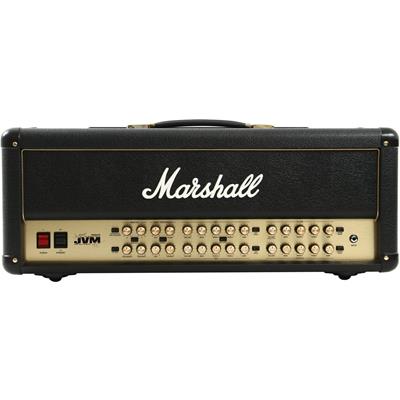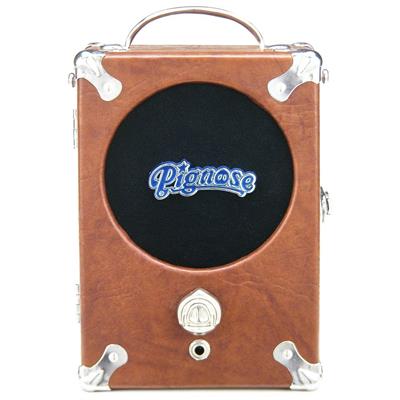| Build Quality: |  |
| Hardware: |  |
| Electronics: |  |
| Sound: |  |
| Value: |  |
| Average: |  |

Pros:
- An extensive set of features
- Individual EQ controls and modes for each channel
- On-board noise gate for each channel
- Outstanding sound quality
Cons:
- Not very portable due to the heavy weight
There are times in your life when just a typical amplifier is not enough. You have a passionate urge for something more, something that is completely authentic and unique. This could mean many different things for each of us, but for me, amplifiers of this ilk are those designed by guitar virtuosos themselves. And what better example could we find other than Marshall JVM410HJS that was constructed and put together in collaboration with Joe Satriani himself? He, along with the Marshall team, created this amplifier with blood, sweat and tears and was not satisfied until it was perfect. Whether you are a fan of Joe or just want a versatile tube amplifier, this model will deliver it all. Let’s get meticulous, dig deep and find out if JVM410HJS is as magical as it promises to be.
Features
Marshall JVM410HJS has so much up its sleeve that I have to get right to the point for this article to be enough for everything. This is a 100-watt tube head that can bark up outstanding power for stage performances. The preamp section operates with four ECC83 valves and one ECC83 phase splitter, while power stage is equipped with four EL334 tubes. This little beast has four channels: Clean, Crunch, OD1 and OD2, as well as three different modes, namely, Green, Orange and Red. Each of these modes enhances the gain in your signal and, thus, intensifies the distortion. The great thing about the channels is that they have the ability to memorize the last settings, which means you will not have to fuss around every time you turn on the device. You could also program Marshall JVM410HJS settings with a footswitch and form Presets that can be easily recalled during the usage. This tube head comes with Silent Recording functionality. You can turn off the standby, which will remove the power stage from the circuitry while leaving the rest operating normally. Additionally, all four channels have individual noise gates to eliminate the unwanted noise. And when you pair them with individual EQs that are extended with presence and resonance controls and you will receive outstanding precision in your tone.
And of course we have to discuss all the sockets and jacks on the Marshall JVM410HJS. We have an input for your instrument, 5 speaker outputs with variable impedance (4, 8, or 16 ohms), send and return jacks for the Series Programmable effects loop, send and return jacks for the passive loop, Emulated Line Out that outputs the signal that is processed through 4×12 speaker cabinet emulator, an input for the 6-way foot controller, as well as MIDI In and Through sockets for activating the MIDI functionality.
Controls
As you take a first glance at Marshall JVM410HJS, the number of knobs you will see might scare the heck out of you, but a more thorough look will show you that there is nothing complicated here. But since we have numerous encoders, I will try to explain each of them and articulate what exactly they do to your sound.
What we have here are several clusters of knobs with different purposes. These are not exactly sections but they are somewhat similar. The first two buttons are FX Loop and Footswitch/MIDI Program. The former activates the effects loop, while the latter engages the footswitch or MIDI programs. Further on we have Master section with two Master knobs and Presence and Resonance. Master 1 and Master 2 are assignable volumes controls to the modes, while Presence and Resonance improve treble and bass response, respectively.
The Gate Threshold section has Enable (activates this function) button and individual noise gate encoders for each channel. Then we have Volume, Bass, Middle, Treble, Gain knobs and Mode buttons for each channel. I am sure you know what they do, so I will not explain them in depth. There is one small modifiable parameter left on the front panel, namely, Mid-Shift. It is available only on OD1 and OD2 channels and basically scoops the mids.
The rare panel features the Return Level knob that modifies the amount of the effect in the effects loop. It can also boost or attenuate your signal with 6dB. And lastly, we have Bypass switch, which allows you to cut the passive loop out of the circuitry.
Marshall JVM-410H Sound
There is no way on earth we can scold the sound Marshall JVM410HJS after discussing such a mouthful of features. There is a lot going on here in terms of sonic versatility, so let’s just get started. The clean channel operates in three modes. The Green one delivers pristine clean tones that have that signature Marshall character. They are clear and defined and most importantly, extremely transparent. Orange and Red modes slightly break up your signal, with the red being a bit more “harsh”. This adds a tiny amount of depth and character and simply makes your distortion pedals sound better. The modes of Crunch channel simply replicate the tone of earlier models. The green is slightly overdriven, while orange and red originated from JCM800 2203 and offer those legendary tones. OD1 and OD2 channels are identical and offer A LOT of gain that increases as you move between the modes. The reason why they are identical, according to Joe, is that this way you can dial in the same sounds with different volumes and EQs and layer on seamlessly. The threshold controls are fantastic, as they eliminate the background noise, spare the audience from that annoying hiss, and allow you to record right on stage. As you can see, even though Marshall JVM410HJS does not have reverb, it does not lack versatility and sonic options.
Conclusion
In the end, all I can say is that the features and sounds of Marshall JVM410HJS speak for themselves. Yeah, signature models are sometimes overpriced, but here you get your money’s worth. This amp head is definitely something you should have the chance to experiment with. Good luck!
Click here to view more from 5 Best Metal Guitar Amps.






